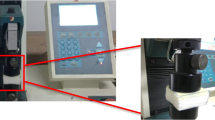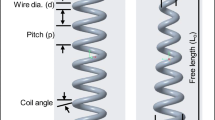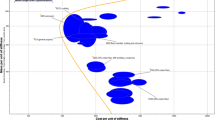Abstract
The mechanical properties such as energy absorption, crushing behavior, and strength-to-weight ratio of graded density structures are significantly better when compared with uniform density counterparts. Graded density structures have been widely investigated due to recent developments in additive manufacturing (AM) technology, which can easily manufacture complex geometries. The study explores the significance of variable-dimension helical spring (VDS) to be used in shoe midsole to improve the stiffness, energy absorption, and energy return. Two novel shoe midsoles are designed using the variable-dimension helical springs and their performance was compared with a third shoe midsole designed using uniform-dimension helical spring (UDS). Variable-dimension shoe midsoles were designed according to the actual pressure distribution applied by the human foot on the midsole. The Multijet fusion AM process was employed for the fabrication of all shoe midsole samples. It is revealed that despite the same mass and bounding box, variable-dimension midsoles have significantly improved mechanical properties compared to uniform-dimension midsole. It is found that the VDS midsole has sixfolds higher force-bearing capacity, and has a lower permanent material setting phenomena when compared to UDS midsole. Moreover, a higher (45%) distortion was found in the UDS midsole after the loading-unloading experiment when compared to the VDS midsole (24%) distortion. A further comparison of the VDS midsole was carried out with the commercially available wave spring-based midsole. Despite about 2-fold higher weight of the wave spring–based midsole, the VDS polymer midsole has higher mechanical properties found in terms of flexibility and force-bearing capacity. Finally, it is concluded that the VDS structure of the midsole can enhance the mechanical properties such as force-bearing capacity, flexibility, and stability with a higher strength-to-weight ratio. This study also proves the feasibility of design and AM of customer-specific shoe midsole.


















Similar content being viewed by others
References
Sun PC, Wei HW, Chen CH et al (2008) Effects of varying material properties on the load deformation characteristics of heel cushions. Med Eng Phys 30:687–692. https://doi.org/10.1016/j.medengphy.2007.07.010
Davia-Aracil M, Hinojo-Pérez JJ, Jimeno-Morenilla A, Mora-Mora H (2018) 3D printing of functional anatomical insoles. Comput Ind 95:38–53. https://doi.org/10.1016/j.compind.2017.12.001
Chiu H-T, Lin H-H (2019) A preference test on shoes with varied distributions of masses. Footwear Sci 11:181–189. https://doi.org/10.1080/19424280.2019.1669077
Gupta N (2007) A functionally graded syntactic foam material for high energy absorption under compression. Mater Lett 61:979–982. https://doi.org/10.1016/j.matlet.2006.06.033
Zhang S, Clowers K, Kohstall C, Yu YJ (2005) Effects of various midsole densities of basketball shoes on impact attenuation during landing activities. J Appl Biomech 21:3–17. https://doi.org/10.1123/jab.21.1.3
Ji J, Li Y, Zhao J (2012) Reverse analysis for determining the stiffness characteristics of suspension spring with variable pitch and wire diameter. Advanced Materials Research.:783–787
Thakare P, Kadlag VL (2017) Design and Analysis of Helical Compression Spring for Special Purpose Application. Int J Adv Res Innov Ideas Educ 3:849–858
Worobets J, Wannop JW, Tomaras E, Stefanyshyn D (2014) Softer and more resilient running shoe cushioning properties enhance running economy. Footwear Sci 6:147–153. https://doi.org/10.1080/19424280.2014.918184
Mahesh CC, Ramachandran KI (2018) Finite element modelling of functionally graded elastomers for the application of diabetic footwear. In: Materials Today: Proceedings. Elsevier Ltd, pp 16367–16377
Weeger O, Boddeti N, Yeung SK et al (2019) Digital design and nonlinear simulation for additive manufacturing of soft lattice structures. Addit Manuf 25:39–49. https://doi.org/10.1016/j.addma.2018.11.003
Brennan-Craddock J, Brackett D, Wildman R, Hague R The design of impact absorbing structures for additive manufacture v7. J Phys Conf Ser open access. https://doi.org/10.1088/1742-6596/382/1/012042
Lombardino TD (1996) Spring-air shock absorbtion and energy return device for shoes
Smith R (1996) Shoe heel spring
Seigle W (1951) Spring cushioning insole
Gallegos AZ (1995) Spring athletic shoe. 435:79
Manville H (1947) Cushioned shoe sole
Shoes A (2017) The Gentlemen’s Spring-Loaded Running Shoes - A running shoes with shock-absorbing springs that relieve the stress and fatigue of running. https://www.boysathleticshoes.com/the-gentlemens-spring-loaded-running-shoes-arunning-shoes-with-shock-absorbing-springs-that-relieve-the-stress-and-fatigue-ofrunning/. Accessed 6 Jul 2020
Cook SD, Kester MA, Brunet ME (1985) Shock absorption characteristics of running shoes. Am J Sports Med 13:248–253. https://doi.org/10.1177/036354658501300406
Nigg BM, Segesser B (1992) Biomechanical and orthopedic concepts in sport shoe construction. Med Sci Sports Exerc 24:595–602
Periyasamy R, Anand S (2013) The effect of foot arch on plantar pressure distribution during standing. J Med Eng Technol 37:342–347. https://doi.org/10.3109/03091902.2013.810788
Liang TC, Lin JJ, Guo LY (2016) Plantar pressure detection with fiber bragg gratings sensing system. Sensors (Switzerland) 16. https://doi.org/10.3390/s16101766
Leal R, Barreiros FM, Alves, L et al Additive manufacturing tooling for the automotive industry. https://doi.org/10.1007/s00170-017-0239-8
Liu R, Wang Z, Sparks T et al (2017) Aerospace applications of laser additive manufacturing. In: Laser additive manufacturing: materials, design, technologies, and applications. Elsevier Inc., pp 351–371
Nazir A, Abate KM, Kumar A, Jeng J-Y (2019) A state-of-the-art review on types, design, optimization, and additive manufacturing of cellular structures. Int J Adv Manuf Technol:1–22. https://doi.org/10.1007/s00170-019-04085-3
Javaid M, Haleem A (2018) Additive manufacturing applications in orthopaedics: A review. J. Clin. Orthop. Trauma 9:202–206
Jiang J, Xu X, Stringer J (2018) Support Structures for Additive Manufacturing: A Review. J Manuf Mater Process 2:64. https://doi.org/10.3390/jmmp2040064
Carbon The perfect fit: Carbon + adidas collaborate to upend athletic footwear. https://www.carbon3d.com/stories/adidas/. Accessed 20 Feb 2019
Jiang J, Xu X, Xiong Y et al (2020) A novel strategy for multi-part production in additive manufacturing. Int J Adv Manuf Technol 109:1237–1248. https://doi.org/10.1007/s00170-020-05734-8
Jiang J, Ma Y (2020) Path Planning Strategies to Optimize Accuracy, Quality, Build Time and Material Use in Additive Manufacturing: A Review. Micromachines 11:633. https://doi.org/10.3390/mi11070633
Jiang J (2020) A novel fabrication strategy for additive manufacturing processes. J Clean Prod 272:122916. https://doi.org/10.1016/j.jclepro.2020.122916
Tilton M, Lewis GS, Manogharan GP (2018) Additive manufacturing of orthopedic implants. In: Orthopedic Biomaterials: Progress in Biology, Manufacturing, and Industry Perspectives. Springer International Publishing, Cham, pp 21–55
Hensleigh RM, Cui H, Oakdale JS et al (2018) Additive manufacturing of complex micro-architected graphene aerogels. Mater Horizons 5:1035–1041. https://doi.org/10.1039/c8mh00668g
Plocher J, Panesar A (2020) Mechanical Performance of Additively Manufactured Fiber-Reinforced Functionally Graded Lattices. JOM 72:1292–1298. https://doi.org/10.1007/s11837-019-03961-3
Geiringer SR (1995) The biomechanics of running. J Back Musculoskelet Rehabil 5:273–279. https://doi.org/10.3233/BMR-1995-5404
Drougkas D, Karatsis E, Papagiannaki M, et al (2018) Gait-specific optimization of composite footwear midsole systems, facilitated through dynamic finite element modelling. https://doi.org/10.1155/2018/6520314
Vandi K (2016) Competitive Edge Physical Therapy: Why Shock Absorption In Running Is NOT About The Shoes. https://www.compedgept.com/blog/why-shockabsorption-in-running-is-not-about-the-shoes. Accessed 6 Jul 2020
Tessutti V, Ribeiro AP, Trombini-Souza F, Sacco ICN (2012) Attenuation of foot pressure during running on four different surfaces: Asphalt, concrete, rubber, and natural grass. J Sports Sci 30:1545–1550. https://doi.org/10.1080/02640414.2012.713975
Sterzing T, Schweiger V, Ding R et al (2013) Influence of rearfoot and forefoot midsole hardness on biomechanical and perception variables during heel-toe running. Footwear Sci 5:71–79. https://doi.org/10.1080/19424280.2012.757810
Richard G, Budynas JKN (2011) Shigley's Mechanical Engineering Design 8th Edition, 10th edn. McGraw-Hill Education, New York, USA
MITCalc (2018) Spring Calculation. www.mitcalc.com. Accessed 6 Jul 2020
Creo Software: PTC’s 3D Modeling CAD software | EACPDS
Dong G, Tessier D, Zhao YF (2019) Design of shoe soles using lattice structures fabricated by additive manufacturing. Proc Des Soc Int Conf Eng Des 1:719–728. https://doi.org/10.1017/dsi.2019.76
ASTM. AS for T and M (2014) Designation: D638-14 standard test method for tensile properties of plastics. Astm 82:1–15. https://doi.org/10.1520/D0638-14
Callister WD, David Rethwisch JG Materials science and engineering
Nazir A, Jeng JY (2019) A high-speed additive manufacturing approach for achieving high printing speed and accuracy. Proc Inst Mech Eng Part C J Mech Eng Sci. https://doi.org/10.1177/0954406219861664
HP 3D Jet Fusion 4200 - Commercial & Industrial 3D Printer | HP® Official Site
O’Connor HJ, Dickson AN, Dowling DP (2018) Evaluation of the mechanical performance of polymer parts fabricated using a production scale multi jet fusion printing process. Addit Manuf 22:381–387. https://doi.org/10.1016/J.ADDMA.2018.05.035
Schenk CA, Schuëller GI (2003) Buckling analysis of cylindrical shells with random geometric imperfections. Int J Non Linear Mech 38:1119–1132. https://doi.org/10.1016/S0020-7462(02)00057-4
Albertin U, Wunderlich W (2000) Buckling Design of Imperfect Spherical Shells. In: Papadrakakis M, Samartin A, Onate E (eds) Proceedings of the International Conference IASS-IACM. ISASR-NTUA, pp 1–20
Li Y-W, Elishakoff I, Starnes JH, Bushnell D (1997) Effect of the thickness variation and initial imperfection on buckling of composite cylindrical shells: Asymptotic analysis and numerical results by BOSOR4 and PANDA2. Int J Solids Struct 34:3755–3767. https://doi.org/10.1016/S0020-7683(96)00230-2
Craft G, Nussbaum J, Crane N, Harmon JP (2018) Impact of extended sintering times on mechanical properties in PA-12 parts produced by powderbed fusion processes. Addit Manuf 22:800–806. https://doi.org/10.1016/j.addma.2018.06.028
Holzmond O, Li X (2017) In situ real time defect detection of 3D printed parts. Addit Manuf 17:135–142. https://doi.org/10.1016/j.addma.2017.08.003
Fayazbakhsh K, Movahedi M, Kalman J (2019) The impact of defects on tensile properties of 3D printed parts manufactured by fused filament fabrication. Mater Today Commun 18:140–148. https://doi.org/10.1016/j.mtcomm.2018.12.003
Nazir A, Ali M, Hsieh C-H, Jeng J-Y (2020) Investigation of stiffness and energy absorption of variable dimension helical springs fabricated using multijet fusion technology. Int J Adv Manuf Technol:1–12. https://doi.org/10.1007/s00170-020-06061-8
Schaedler TA, Jacobsen AJ, Torrents A et al (2011) Ultralight metallic microlattices. Science 334:962–965. https://doi.org/10.1126/science.1211649
Lin D, Zhou C (2017) Guinness World Records names graphene aerogel as world’s least dense 3-D printed structure. https://phys.org/news/2017-06-guinness-world-grapheneaerogel-dense.html. Accessed 6 Jul 2020
Hrubesh TMT, LW (1992) Transparent ultralow-density silica aerogels prepared by a two-step sol-gel process. 145:44–50
Verdooren A, Chan HM, Grenestedt JL et al (2006) Fabrication of low-density ferrous metallic foams by reduction of chemically bonded ceramic foams. J Am Ceram Soc 89:3101–3106. https://doi.org/10.1111/j.1551-2916.2006.01225.x
Tappan BC, Huynh MH, Hiskey MA et al (2006) Ultralow-density nanostructured metal foams: Combustion synthesis, morphology, and composition. J Am Chem Soc 128:6589–6594. https://doi.org/10.1021/ja056550k
Singhal P, Small W, Rodriguez JN, et al (2012) Ultra low density amorphous shape Memory polymer foams. Ultra low density amorphous shape memory polymer foams. Philadelphia
Zhang L, Yilmaz ED, Schjødt-Thomsen J et al (2011) MWNT reinforced polyurethane foam: Processing, characterization and modelling of mechanical properties. Compos Sci Technol 71:877–884. https://doi.org/10.1016/j.compscitech.2011.02.002
Defonseka C (2016) Practical guide to water-blown cellular polymers, Ist. Smithers Rapra Technology
Funding
This work was financially supported by the High-Speed 3D Printing Research Center (Grant No. 108P012) from the Featured Areas Research Center Program within the framework of the Higher Education Sprout Project by the Minister of Education (MOE) Taiwan.
Author information
Authors and Affiliations
Corresponding author
Additional information
Publisher’s note
Springer Nature remains neutral with regard to jurisdictional claims in published maps and institutional affiliations.
Rights and permissions
About this article
Cite this article
Ali, M., Nazir, A. & Jeng, JY. Mechanical performance of additive manufactured shoe midsole designed using variable-dimension helical springs. Int J Adv Manuf Technol 111, 3273–3292 (2020). https://doi.org/10.1007/s00170-020-06227-4
Received:
Accepted:
Published:
Issue Date:
DOI: https://doi.org/10.1007/s00170-020-06227-4




